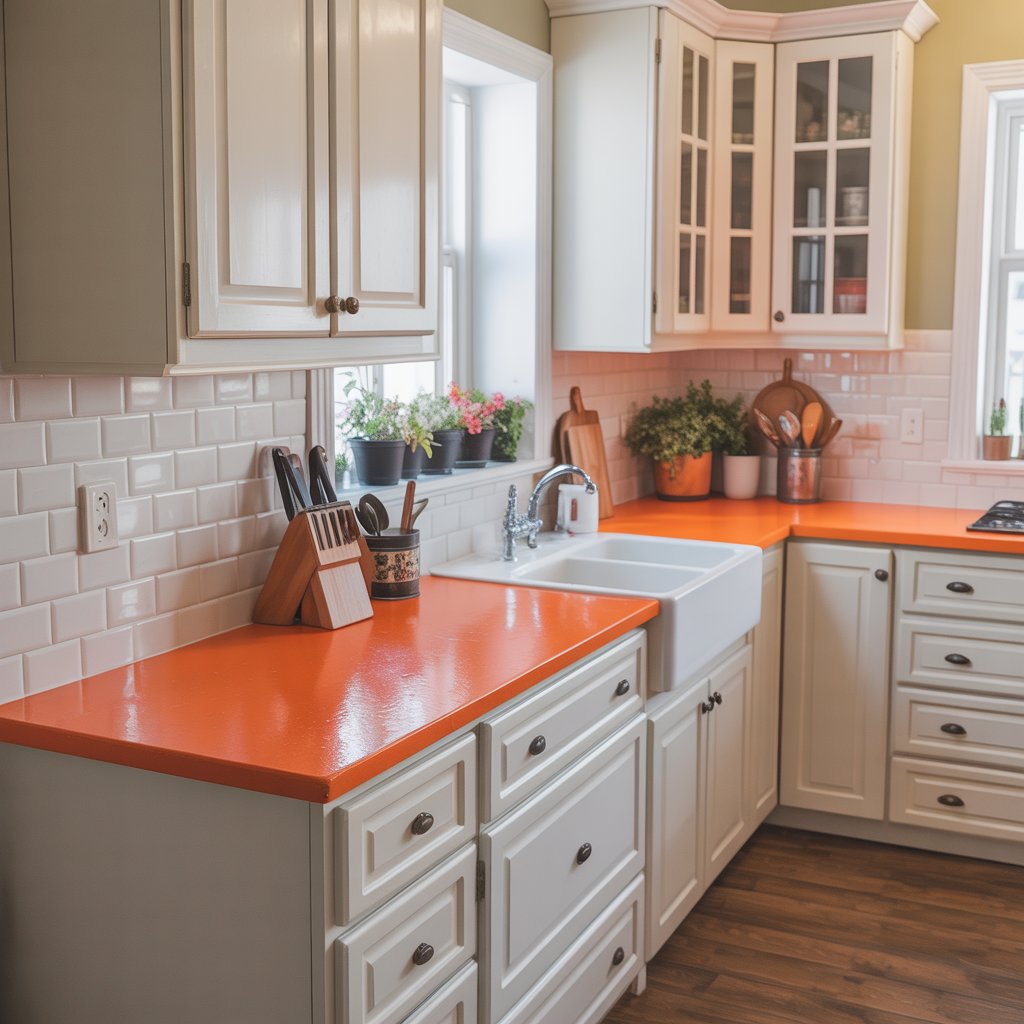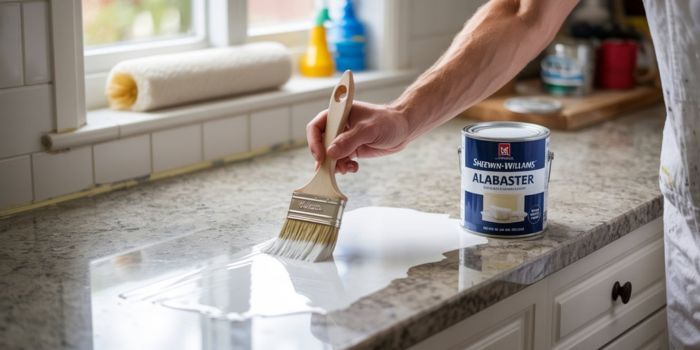Revamping your kitchen doesn’t have to drain your wallet painting countertops is a rising trend among savvy homeowners seeking affordable transformation. Believe it or not, you can paint kitchen countertops.
With careful prep work, quality primers, and resilient topcoats, the results can be striking faux granite, marble, or stone finishes that rival the real thing. It’s a clever, creative solution for breathing new life into tired surfaces without the hefty price tag.
1. Why Paint Kitchen Countertops?

Revamping tired, outdated countertops through painting offers an ingenious, cost-effective alternative to full-scale renovations.
Rather than investing heavily in new stone or laminate, you gain artistic freedom selecting hues and patterns that echo your kitchen’s essence.
From worn Formica to dated tile, countless DIYers have breathed new life into their surfaces. The result? A bold, refreshed space that feels custom-crafted, without the upheaval or expense of a complete countertop replacement.
2. How to Paint Kitchen Countertops

Step 1: Thorough Cleaning and Preparation
A flawless paint job hinges not merely on skill but on meticulous preparation. Begin by scrubbing countertops diligently, eliminating every trace of grease, wax, and stubborn residue.
Don’t just clean—revive the surface with a specialty product like Amy Howard’s Clean Slate for optimal paint adhesion.
Neglecting this crucial step? Expect peeling, chipping, and disappointment to follow swiftly. Preparation isn’t optional; it’s the invisible foundation of a lasting, professional finish.
Step 2: Priming
Priming plays a pivotal role in ensuring long-lasting adhesion, especially on glossy or slick surfaces. Opt for a premium-quality primer specifically formulated for such challenging textures.
Many experts suggest working in small, controlled sections—roughly two feet wide—to promote an even coat and prevent unsightly brush marks or patchy drying.
Patience is key: let the primer cure fully, typically for eight hours or overnight, before advancing to the next stage of your project.
Step 3: Painting
For painting projects, opt for richly pigmented chalk-based options like Amy Howard’s One-Step or mineral infused DIY kits they deliver velvety coverage with minimal effort.
When attempting decorative finishes such as faux marble, blend hues wet-on-wet to achieve fluid transitions. Employ sponges for broader textures and fine brushes for intricate zones like backsplashes or corners.
Precision matters—gentle strokes and deliberate pacing prevent unsightly blotches or uneven buildup. Let artistry guide each careful layer.
Step 4: Sealing
To safeguard your freshly painted countertops from the relentless assault of moisture, unsightly stains, and daily wear, a robust sealer is essential.
Opt for heavy-duty finishes like Gator Hide or epoxy-based sealants, both known for their resilient, glass-like protection. Apply multiple layers, allowing ample drying between each.
This meticulous step, though time-consuming, ensures your countertops retain both their visual allure and practical durability for countless years to come.
3. Benefits and Considerations

Transforming countertops with paint is a budget-friendly, highly customizable endeavor perfect for DIY enthusiasts willing to invest time and precision.
While this approach offers visual appeal and flexibility, especially for renters or future renovators, it lacks the durability of granite or premium laminates.
Heat and scratch resistance are limited, so gentle handling is essential. Still, for a temporary yet stylish refresh, painted countertops provide a versatile, reversible solution without the hefty price tag.
4. Best Paint Options for Countertops
- Epoxy Paint – Durable and glossy, often used for faux granite looks.
- Acrylic Latex Paint + Sealant – Good for laminate, budget-friendly.
- Chalk Paint + Wax or Polyurethane – Ideal for rustic styles, but needs sealing.
5. When You Shouldn’t Paint Your Countertops
- Deeply damaged or warped surfaces
- Countertops exposed to extreme moisture or heat
- When a long-term renovation is around the corner
Conclusion
Absolutely you can paint kitchen countertops, transforming weary surfaces into refreshed focal points without breaking the bank.
Though not as impervious to heat or scratches as granite or quartz, painted counters when properly prepped and sealed can be surprisingly resilient.
This DIY upgrade isn’t permanent, but for budget-conscious homeowners or renters craving change, it delivers style and charm. Just temper expectations and embrace the character that comes with a beautifully imperfect transformation.
Frequently Asked Questions
1. Can you really paint kitchen countertops?
Yes, you can paint kitchen countertops using the right type of paint and proper preparation. It’s a budget-friendly way to refresh outdated or worn countertops without a full replacement.
2. What types of countertops can be painted?
Most commonly painted surfaces include:
- Laminate (e.g., Formica)
- Wood
- Concrete
With proper priming, even tile and solid surfaces like Corian can be painted, although durability may vary.
3. What kind of paint should I use for countertops?
Use paints designed for high-traffic and moisture-prone areas. Popular options include:
- Epoxy paint – durable and glossy
- Acrylic latex paint with a polyurethane topcoat
- Countertop paint kits – specifically designed for kitchen surfaces
4. Do I need to prime the countertops before painting?
Yes. Proper priming is essential. Use a high-bonding primer to ensure paint adhesion and long-lasting results, especially on laminate or glossy surfaces.
5. How do I prepare my countertops for painting?
Steps include:
- Thorough cleaning to remove grease and residue
- Light sanding to dull the surface
- Applying painter’s tape to protect adjacent areas
